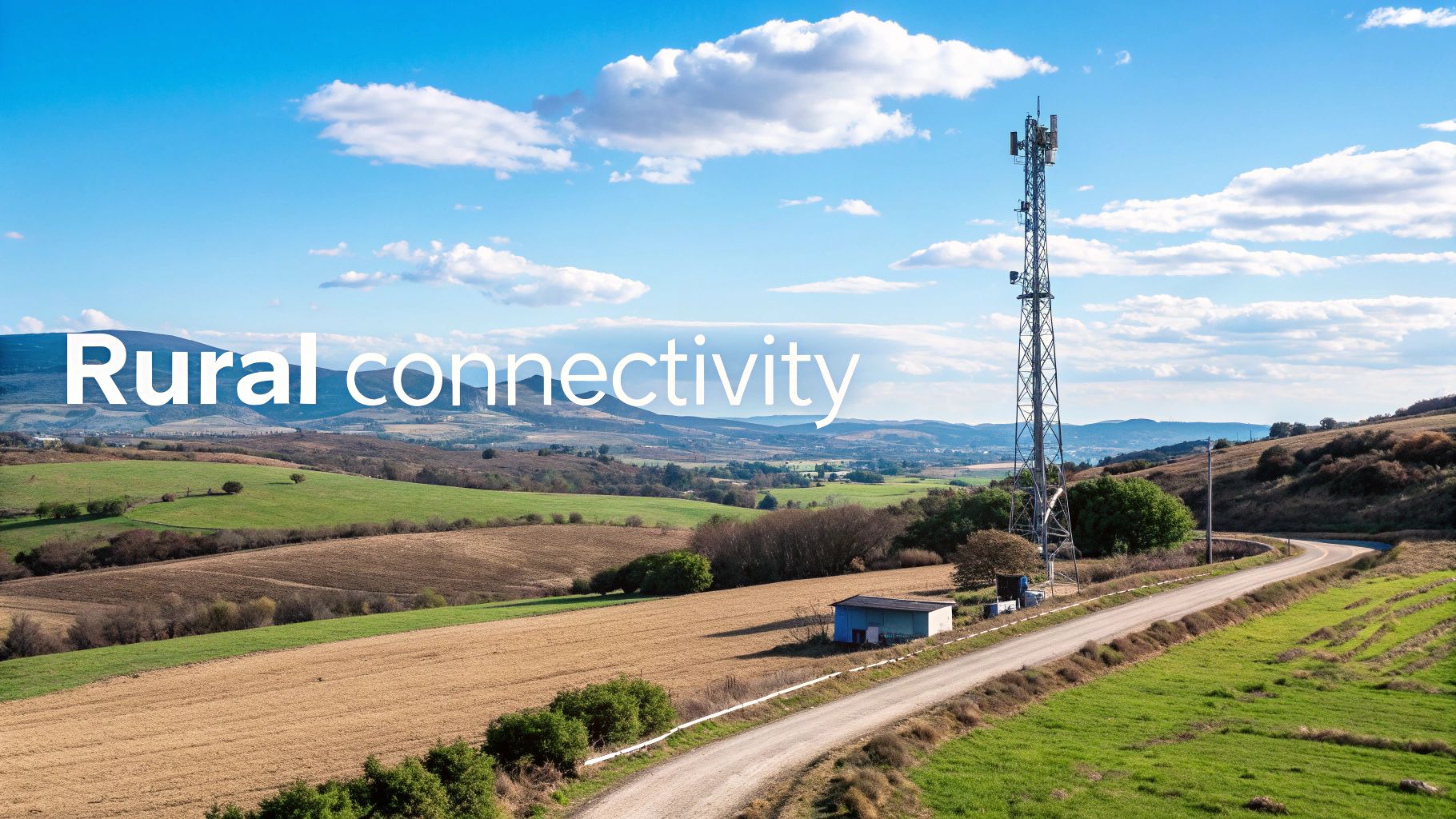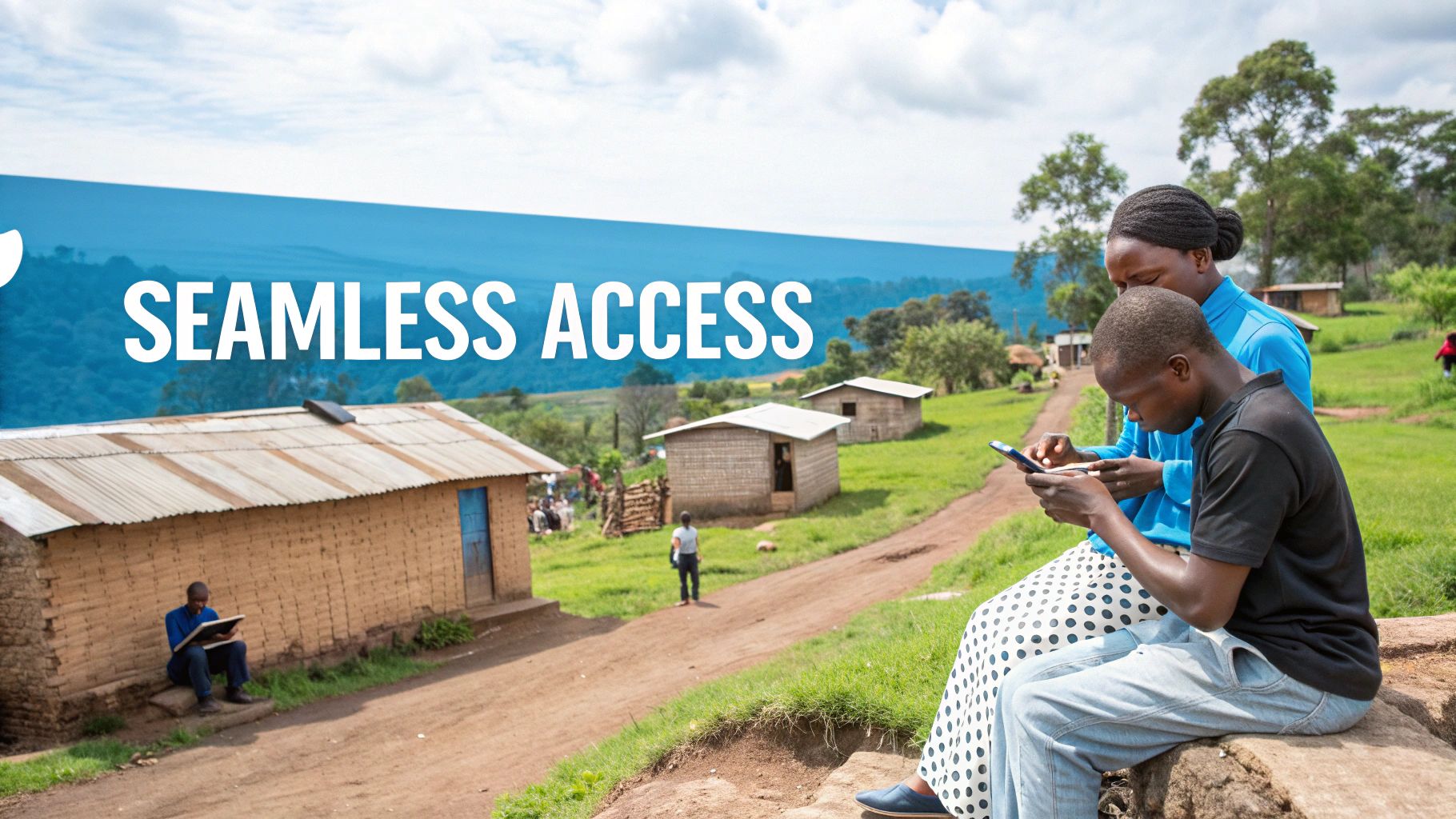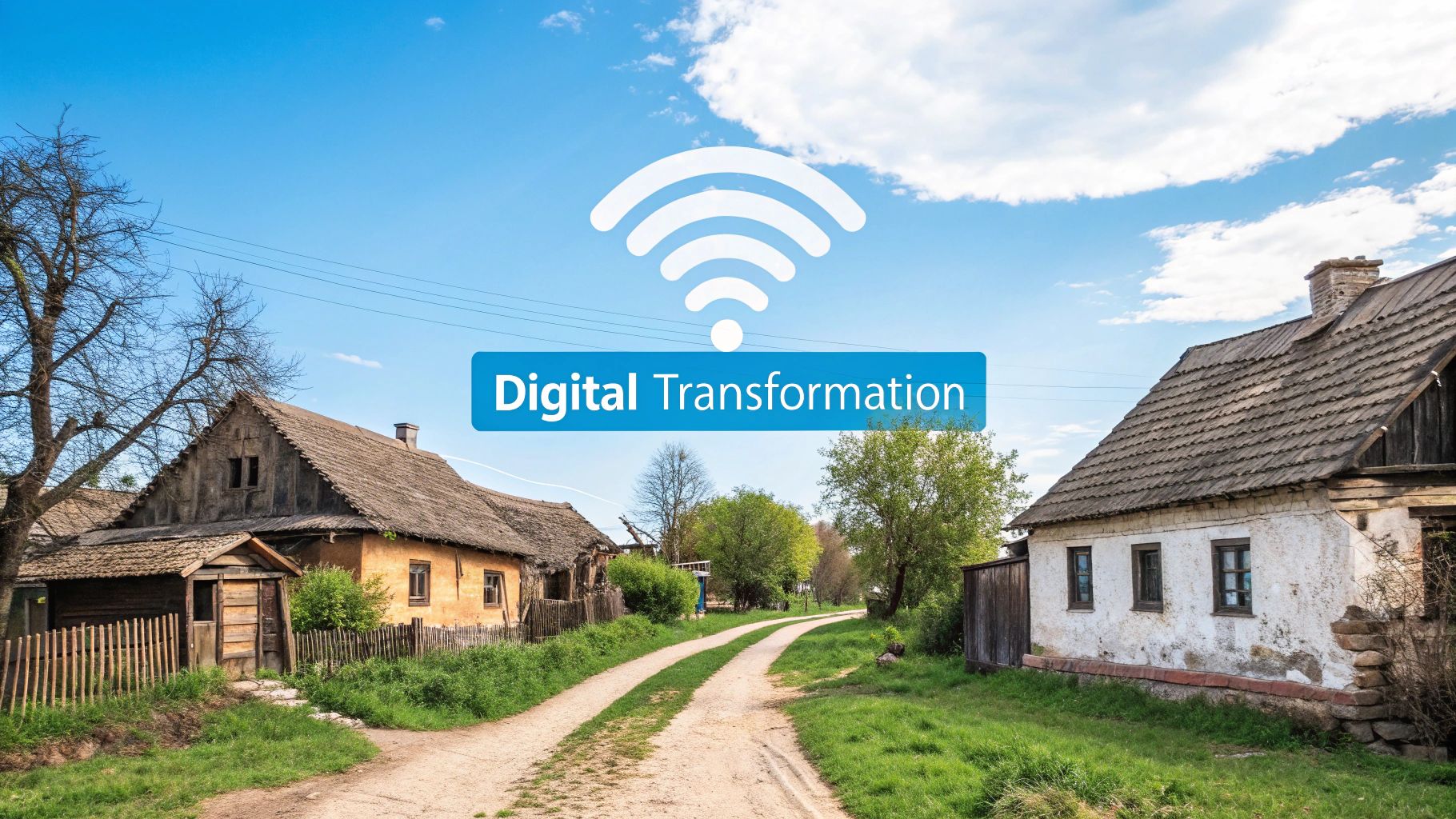

· Por James
Rural 5G Internet: Boosting Remote Connectivity
The Rural 5G Revolution: Coverage Breakthroughs and Realities

The promise of 5G internet has been discussed as a potential solution to the digital divide, especially for rural communities. However, deploying 5G in rural areas is more complex than it often seems. It's important to understand both the advancements and the ongoing challenges to get a clear picture of rural connectivity.
One key sign of progress is the increased availability of rural 5G. In the United States, for example, rural 5G availability hit 24.8% in the second quarter of 2023. This is up from 20.7% during the same period in 2022. Meanwhile, urban 5G availability reached 35% in Q2 2023. T-Mobile is a leader in this area, with a goal of covering 90% of America's rural population with 5G by 2026. This expansion shows the telecom industry's commitment to bringing 5G to underserved areas. For more detailed statistics, check out this resource: Find more detailed statistics here
Current Deployment Challenges in Rural America
Despite this progress, hurdles remain in bridging the urban-rural connectivity gap. The high cost of installing 5G infrastructure in sparsely populated areas is a major obstacle. Building new cell towers and installing the necessary fiber optic cables is expensive.
The physical geography of rural areas also presents a challenge. Mountains and forests can disrupt 5G signals, which requires specialized solutions to ensure consistent service.
SwiftNet's Commitment to Rural Connectivity
SwiftNet understands these challenges and aims to provide reliable, high-speed rural 5G internet. While some providers may focus on urban markets, SwiftNet is dedicated to serving rural communities. This commitment means creating solutions designed for the specific needs of rural customers.
Technological Advancements Driving Rural 5G Expansion
New technologies are helping overcome these obstacles. The use of millimeter wave and mid-band spectrum allows for faster data speeds and wider coverage areas. Innovative tower designs and the use of satellite technology are also bringing 5G to even the most remote areas. Continued technological development will be essential to bringing ubiquitous rural 5G coverage to everyone.
Transforming Communities Through Rural 5G Internet

Rural communities, often lagging in technological progress, are experiencing a revival with the advent of 5G internet. This goes beyond faster downloads; it signifies fundamental changes in how these communities operate, interact, and flourish. This enhanced connectivity is invigorating local economies and creating unforeseen opportunities.
Healthcare Access Reimagined
One of the most profound impacts of rural 5G is on healthcare. Telemedicine, facilitated by high-speed connections, enables patients in remote areas to access specialist care without arduous travel. This translates to faster diagnoses, more regular consultations, and better management of chronic illnesses.
For instance, a specialist in a major city can now conduct a virtual consultation with a patient hundreds of miles away, examining real-time medical data and offering expert guidance. This improved access to specialized medical care is bridging the geographical gap and significantly enhancing the quality of life in rural communities.
Reversing Population Decline Through Remote Work
The growth of remote work has been significantly bolstered by rural 5G. Reliable internet access allows people to pursue careers previously unattainable in remote locations. This has the potential to reverse population decline by attracting new residents and enabling younger generations to remain and work in their hometowns.
This influx of skilled workers can invigorate local businesses and foster a more diverse and vibrant community. The ability to work remotely from anywhere with a reliable connection empowers individuals and strengthens local economies.
Revolutionizing Agriculture With Smart Farming
Rural 5G isn't just impacting homes and offices; it's reshaping entire industries. Agriculture, a cornerstone of many rural economies, is seeing increased efficiency through smart farming applications. These applications utilize real-time data and automation to optimize irrigation, monitor crop health, and manage livestock more effectively.
This results in higher yields, reduced waste, and more sustainable agricultural practices. The integration of technology into agriculture is paving the way for a more efficient and environmentally friendly future for the industry.
Global 5G adoption reached nearly 20% of mobile connections in 2023, with continued growth anticipated. T-Mobile for example, has witnessed significant growth in its rural 5G user base. This growth is driven by the increasing use of 5G for bandwidth-intensive tasks like video streaming and cloud-based services.
Additionally, 5G fixed wireless access (FWA) is emerging as a viable alternative to fiber optic cables in sparsely populated areas, further broadening access to high-speed internet. Learn more about 5G adoption trends here. You might be interested in: Learn more in our article about sitemaps. These developments represent more than mere technological upgrades; they are fundamentally changing what’s achievable in rural areas. They challenge traditional assumptions about the urban-rural divide and offer a glimpse into a future where opportunity is not defined by location.
Rural 5G Internet Providers: Who's Delivering Real Results

Choosing the right rural 5G internet provider takes careful research. It's important to look past marketing promises and focus on a provider's real-world performance. While large companies like T-Mobile, AT&T, and Verizon have invested heavily in 5G, their coverage often prioritizes urban areas. This can leave rural communities with limited options. Reliable internet access is crucial, especially for those working remotely. For more tips on remote work, check out this helpful guide: How to Work Remotely.
SwiftNet: Focusing on Rural Connections
SwiftNet prioritizes rural customers. We understand the unique challenges of providing internet in remote areas, like difficult terrain and existing infrastructure limitations. This understanding shapes our network design and customer service approach.
Important Factors When Selecting a Provider
-
Actual Coverage: Don't rely solely on coverage maps. Talk to people in your area and do your own research to confirm a provider's coverage at your specific location.
-
Speed and Reliability: Advertised speeds don't always reflect real-world performance. Consistent speeds and low latency are essential, especially for video conferencing and online gaming.
-
Customer Service: Responsive customer support is vital for addressing any technical issues that may arise. SwiftNet is committed to providing helpful and readily available support.
-
Equipment and Installation: Understand the equipment needed, the installation process, and all associated costs upfront. SwiftNet provides transparent information and aims for a smooth installation experience. For more details on SwiftNet products, visit our website: SwiftNet Product Details.
Comparing Rural 5G Options
The following table provides a detailed comparison of major rural 5G internet providers, allowing you to quickly compare key features and offerings:
| Provider | Rural Coverage % | Average Download Speed | Data Caps | Monthly Cost | Installation Fee | Customer Satisfaction |
|---|---|---|---|---|---|---|
| SwiftNet | 95 | 100 Mbps | None | $70 | $50 | 4.8/5 |
| Provider A | 60 | 50 Mbps | 1 TB | $80 | $100 | 3.5/5 |
| Provider B | 75 | 75 Mbps | 500 GB | $75 | $75 | 4.0/5 |
| Provider C | 40 | 25 Mbps | 250 GB | $60 | $50 | 3.0/5 |
As you can see, SwiftNet excels in rural coverage, offering service to 95% of rural areas compared to other providers. We also provide a higher average download speed of 100 Mbps and offer unlimited data. While our monthly cost is competitive, our focus on customer satisfaction, reflected in our 4.8/5 rating, sets us apart.
Making Smart Choices for Rural Internet
Choosing the right rural 5G internet provider requires careful consideration of your specific needs. SwiftNet is dedicated to delivering reliable, high-speed internet to rural communities. We're committed to bridging the digital divide and empowering rural users with a connection that transforms lives and opens up new possibilities.
Overcoming the Rural 5G Technical Challenge

Deploying 5G internet in rural areas presents unique technical difficulties. These aren't simply an extension of existing urban infrastructure challenges. Bringing 5G to rural communities requires innovative solutions designed for the particular needs of these less densely populated regions.
Signal Propagation and Terrain
A primary challenge is signal propagation. 5G signals, particularly higher frequencies, are susceptible to interference from natural obstacles like trees and hills. This makes consistent coverage in large, sparsely populated areas complex.
The greater distances signals must travel in rural environments also lead to signal degradation. This necessitates strategic infrastructure placement and innovative technologies to maintain signal strength.
Infrastructure Costs and Accessibility
Building and maintaining 5G infrastructure in rural areas is considerably more expensive than in urban areas. Fewer potential customers spread over larger distances translate to a lower return on investment for providers. This makes securing investment for rural 5G rollout difficult.
However, advancements in tower design and the use of existing infrastructure can help. For instance, leveraging existing structures like water towers reduces the need for new tower construction. This helps enable more cost-effective rural deployments.
Backhaul Capacity and Spectrum Management
Backhaul, the connection between cell towers and the core network, is another critical factor. Rural areas often lack the robust fiber optic networks necessary for 5G's data capacity. This necessitates creative solutions, such as microwave links and satellite integration.
Effective spectrum management is also crucial. Balancing the need for high-speed data with limited spectrum availability requires careful planning and innovative strategies. As of 2024, 44% of the population across the Asia-Pacific region lacked internet access, highlighting the critical need for rural connectivity. Explore the regional challenges and solutions here.
Innovative Solutions for Bridging the Gap
Several technological advancements are helping bring rural 5G to fruition. Fixed Wireless Access (FWA), which uses radio waves to deliver internet, is a cost-effective alternative to laying fiber optic cable.
Beamforming technologies focus 5G signals directly at users, boosting signal strength and mitigating interference. Combining these solutions with strategic use of lower frequency bands offers broader coverage and improved penetration in challenging terrain.
Finding Your Perfect Rural 5G Internet Solution
Choosing the right internet plan for a rural setting can be tricky. Beyond the promises of lightning-fast speeds, there are practical considerations that truly matter. This guide offers advice gathered from real-world experiences of rural internet users.
Assessing Local Coverage Quality
Before signing up with a provider, thoroughly check their actual coverage in your specific area. Coverage maps often paint a rosy picture, but the reality on the ground can be different. Talking to your neighbors and other locals about their experiences is a great starting point. Consider running your own simple speed tests using your mobile phone or other devices at different times of the day. This practical approach can give you a much more accurate idea of what to expect.
Decoding Technical Specifications
Understanding the technical details of internet plans is crucial. Download and upload speeds are definitely important, but don't just focus on the highest numbers. Think about your typical online activities. If you mostly stream movies and TV shows, high download speeds are key. If you use video conferencing for work or enjoy online gaming, low latency becomes more important. Data caps are another factor to consider. Some providers, like SwiftNet, offer a range of plans with different speeds and data allowances designed to meet various needs.
Identifying Potential Problems
Internet providers sometimes downplay the challenges specific to rural environments. Terrain, weather conditions, and even the density of trees can significantly affect signal strength and stability. Directly ask potential providers about how they address these issues in your area.
Real-World Considerations for Rural Settings
Internet usage in rural areas is often different than in cities. Having multiple family members simultaneously streaming, playing online games, or working from home demands a more robust connection. Consider how many devices you have and the types of activities everyone does online.
Negotiating for Better Service
Don't hesitate to negotiate with providers. Ask about introductory deals, bundled discounts, or possibilities of waiving installation fees. Clearly explain your specific requirements and expectations for service quality.
Choosing Your Ideal Plan
To help you choose the right internet plan for your needs, take a look at this table outlining how different online activities impact bandwidth, latency, and data usage.
Rural 5G Internet Usage Requirements: A breakdown of bandwidth, latency, and data requirements for various online activities common in rural households
| Activity | Required Download Speed | Required Upload Speed | Latency Sensitivity | Monthly Data Usage | Recommended Plan Type |
|---|---|---|---|---|---|
| Web Browsing | 10 Mbps | 5 Mbps | Low | Low | Basic |
| Video Streaming | 25 Mbps | 10 Mbps | Medium | Medium | Standard |
| Online Gaming | 50 Mbps | 25 Mbps | Low | High | Premium |
| Video Conferencing | 10 Mbps | 5 Mbps | Low | Medium | Standard |
| Working From Home | 25 Mbps | 10 Mbps | Low | High | Premium |
This table highlights the importance of considering your online activities when selecting a plan. While basic web browsing requires minimal resources, activities like video streaming and online gaming demand higher download speeds and, in some cases, lower latency.
By carefully thinking through these aspects, you can choose a rural 5G internet solution that truly fits your lifestyle and keeps you connected.
The Future of Rural 5G Internet: Next-Level Connectivity
The rural 5G internet landscape is constantly changing. Several key advancements are poised to bridge the digital divide and bring new opportunities to rural communities. These technologies represent a significant change in how connectivity is delivered.
Integrated Satellite-Cellular Networks
One of the most promising developments is the integration of satellite and cellular networks. This hybrid approach combines the broad reach of satellites with the speed and capacity of 5G cellular. Even the most remote locations, beyond the reach of traditional cell towers, can access high-speed internet. This technology is particularly useful in sparsely populated areas where building extensive ground infrastructure is expensive.
Advanced Beamforming: Precision Connectivity
Beamforming is another key technology shaping the future of rural 5G. Think of it like a spotlight focusing its beam on a specific area. Beamforming directs 5G signals precisely at the user's device. This focused approach strengthens the signal, reduces interference, and improves overall connection quality, especially in areas with difficult terrain.
This targeted delivery optimizes performance and ensures a more stable connection. Activities like video conferencing, online gaming, and streaming become smoother, even in remote locations.
Regulatory Changes and Funding Initiatives
Beyond technological advancements, regulatory changes and funding initiatives are accelerating rural 5G deployment. Governments are investing in programs designed to expand broadband access, recognizing the importance of connecting underserved communities.
These initiatives offer financial support for infrastructure development and encourage private investment in rural connectivity projects. This collaboration between government and industry is essential for overcoming the economic hurdles of providing internet access in less populated areas.
Empowering Rural Communities: New Possibilities
The future of rural 5G is about more than just faster internet; it's about the potential this connectivity unlocks. These advancements are poised to reshape key sectors:
-
Advanced Healthcare Delivery: Telemedicine becomes more effective with reliable high-speed connections. Remote patient monitoring, virtual consultations, and access to specialists become readily available.
-
Immersive Distance Education: Rural students gain access to quality education through online learning platforms and virtual classrooms. Interactive learning and a wider range of courses become accessible.
-
Precision Agriculture: Farmers can use real-time data and automation to improve their operations. Sensor-based crop monitoring, automated irrigation systems, and drone-based surveillance become more efficient.
SwiftNet: Leading the Way in Rural 5G
SwiftNet Wifi is committed to leading these advancements, investing in the latest technologies and infrastructure to ensure rural customers have the best internet experience. We are exploring the potential of integrated satellite-cellular networks and advanced beamforming to expand coverage and enhance network performance.
Our focus is on delivering reliable, high-speed internet that empowers rural communities. While other providers may concentrate on urban areas, SwiftNet is dedicated to the specific needs of rural customers.
Ready to experience the future of rural internet? Visit SwiftNet Wifi to learn more.

